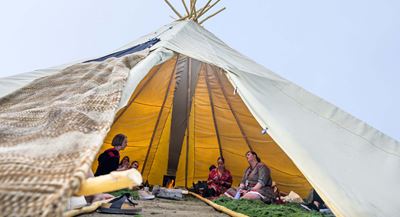
The invasion of Ukraine by Russia suspended partnerships between Russian institutions and UArctic’s Thematic Network on Arctic Sustainable Arts and Design (ASAD). The focus of ASAD's initiatives has now shifted towards forming partnerships within the Canadian Arctic with the overall goal of the network to promote art, culture, and education for Arctic sustainability.
By Aubyn O’Grady, Program Director, Yukon School of Visual Arts and Timo Jokela, Lead of the UArctic Thematic Network on Arctic Sustainable Arts and Design, UArctic Chair in Arctic Art, Design and Culture, Professor, University of Lapland
In 2022-2023 this new collaboration has been demonstrated by two circumpolar events: the Arctic Arts Summit (AAS) held in Whitehorse, Yukon in July 2022, and the ASAD network’s tenth annual Relate North Symposium and Exhibition, hosted by the Yukon School of Visual Arts and Yukon University in January 2023.
Prior to the Whitehorse event, the Arctic Arts Summit was last hosted in Rovaniemi, Finland in 2019. The focus was primarily on disseminating and discussing the work of researchers, with the ASAD network’s research guiding many of the conversations. Five key priorities for the sustainability of art and art education in the Arctic were highlighted: (1) global politics and ecological crises; (2) relations of Indigenous and non-Indigenous art; (3) “handmade”; (4) place-making, revitalization, and regional development; and (5) economy and sustainability. These priorities speak to the challenge for many ASAD network partners; the challenge to make art and arts-based research that can move between the worlds of art and academia, while also being legible to the broader communities our work circulates in or draws from.
The organizers of the third Arctic Arts Summit in Whitehorse focused on showcasing circumpolar Indigenous visual and performing arts. The event was animated by many performances, artist exhibitions, and panels that included the voices of artists, academics, and representatives of Arctic arts organizations, non-profits, and national arts councils. The ASAD network also organized two panels at the Summit.
The Indigenous and Northern Collaborative Research and Education Engagement Fund - funded by Global Affairs Canada, and channeled through UArctic for developing new cooperative projects on networking activities related to Arctic research and education - enabled the Yukon School of Visual Arts (Yukon SOVA) to host the Relate North 10 Symposium and Exhibition. This is a significant new partnership for Yukon SOVA, a small visual arts school in the sub-Arctic community of Dawson City, Yukon, situated within the Traditional Territory of the Tr’ondëk Hwëch’in. Yukon SOVA is located in the Applied Arts Division of Yukon University, and co-governed by the Klondike Institute for Arts & Culture, and the Tr’ondëk Hwëch’in Government.
The theme of Relate North 10 was Possible Futures; a direct engagement with one of the themes identified by the 2022 Arctic Arts Summit. Arctic communities are at the forefront of imagining alternative futures in a rapidly changing present. Across the ASAD network there are many examples of initiatives that are actively working towards creating alternatives, from land-based educational projects to the inclusion of Indigenous language and cultural revitalization programming, and to collaborations between community-led and arts-based researchers and scientists. Relate North 10 was about cultivating circumpolar relations between the network partners to mobilize and share examples of what works at each research and creative site. The symposium also involved discussions about how to ethically and intentionally evolve institutions, projects, and practices to align with, support, and enact the many possible futures that have already been envisioned in the Arctic.
There is great potential and a growing need for sustainable arts, design, and creative industries to support the wellbeing of Arctic residents through transatlantic collaborations such as the ASAD network. As Arctic regions continue to experience the accelerated effects of climate change, global geopolitical tensions, and resource development pressures, it is a critical time to bring Canadian, American, and Scandinavian arts institutions together to share knowledges, experiences, best practices, and projects being done to address global issues that are felt regionally, particularly for those in the North. The Relate North 10 Symposium and Exhibition is an example of the kind of partnership that is necessary to collectively imagine possible futures in the Arctic.